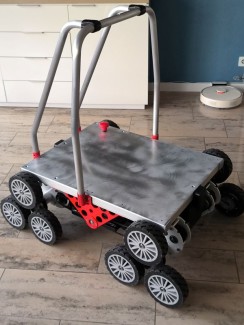The history of this robot began with the fact that I bought a house on a hillside. Everything was great until I had to carry weights up and down the stairs. My patience snapped when I rented a two-wheeled soil loosening machine and couldn't get it up the stairs. I realized that not only I have such a problem, but also hundreds of thousands of people like me. For example, all my neighbors suffer from this problem. It is very annoying when small or larger obstacles cause large financial and physical costs. I realized that I need an all-terrain robot that I can use to lift and lower loads up and down stairs, a lawn mower, a lawn watering robot, a snow sweeper in winter, an assistant with tools for manual work, a robot for independent shopping in the market and just a small truck. I had two options for solving the problem. The first option is a robot with four stairs wheels. And the second option is a robot copter. I would like to show the first version of the all-terrain vehicle robot. This is not a final version, a pre-production version that I tested. A copter robot is also being created, but unlike the original idea, it also turns into a device of near-Earth flights with possibility to reach moon and return back to the Earth.
At this stage, the driving performance of the robot is checked, a list of design improvements is compiled. A new speed variator will be implemented. Existing variators for a scooter or car are not suitable for a robot. A new variator was invented with a possible transmission ratio from 1 up to 20 and a possible torque of 100-200Nm. Design documentation for serial production is being created. The test period is 4-5 months.
This milestone is done but still without new variator, because it takes many efforts.
At this stage, machine vision is implemented based on Intel realsense d435, 2D lidar and two micro motors. Lead time 6-7 months. Upon completion of this stage of work, the robot will independently lay the optimal route, avoid collisions, let pedestrians pass, and return from a dead end. The software will be built on the principle of a neural network.
At this stage, mass production of the robot will begin.
At this stage, prototypes of the engine and stabilizer components for the copter will be created. The engine and stabilizer will be isolated from the environment. The copter itself will not have any propeller or jet ejection or any combustible fuel.
At this stage, the lifting and flying qualities of the copter will be checked.


